Fall of Singapore anniversary: Praise for courage of Australia's 'magnificent' POWs, veterans
Updated
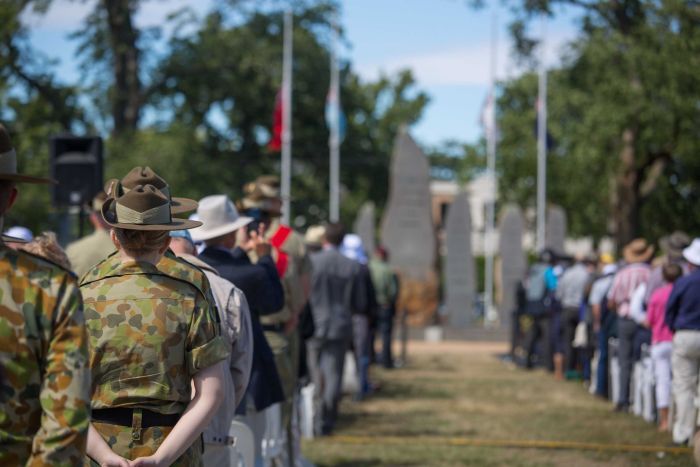 Photo:
The anniversary of the fall of Singapore was marked by a commemoration in Ballarat. (ABC News: Margaret Burin)
Photo:
The anniversary of the fall of Singapore was marked by a commemoration in Ballarat. (ABC News: Margaret Burin)
The lives of those who died and suffered during the fall of Singapore, in World War II, have been remembered at a commemoration of the 75th anniversary.
About 130,000 allied troops were taken prisoner, including 15,000 Australians, when Japanese forces streamed into Singapore across the Straits of Jahore in February 1942.
Governor-General Sir Peter Cosgrove joined hundreds of others at a ceremony to mark the moment, recognised as Britain's worst 20th century military loss.
Speaking in the central Victorian city of Ballarat — the home of the country's only ex-prisoner of war memorial — Sir Peter said the fall of Singapore was a seminal moment in the war and its influence on our security is still felt today.
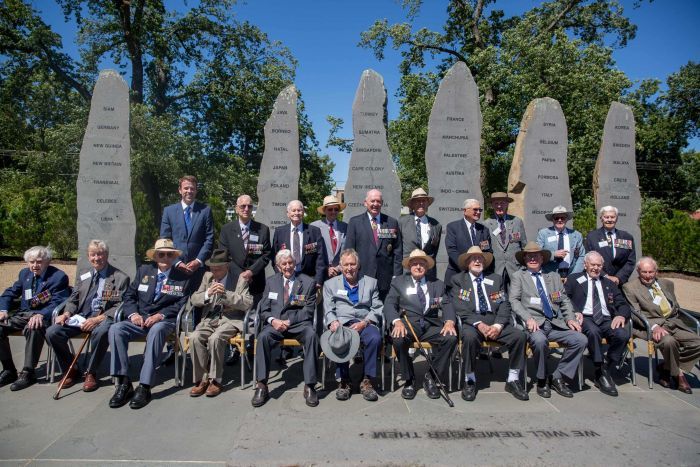 Photo:
Sir Peter Cosgrove met with Australian veterans of the fall of Singapore during the anniversary ceremony. (ABC News: Margaret Burin)
Photo:
Sir Peter Cosgrove met with Australian veterans of the fall of Singapore during the anniversary ceremony. (ABC News: Margaret Burin)
He also paid tribute to the courage and resilience of Australian troops and prisoners of war (POWs) who endured "unimaginable horror", often being beaten "to the edge of death".
"For those magnificent, gallant men and women, whether in uniform or not, theirs was not explosive and immediate courage of the battlefield, be it on land or at sea or in the air," he said.
"It was instead a slow burn courage, stoic, enduring, often unto death, a courage of daily sacrifice and determination not to give in, not to despair.
"This unquenchable fortitude got many through those dark times.
"It eased the suffering of those who did not survive and preserved the dignity and humanity that captvity and ill treatment could not dampen or displace."
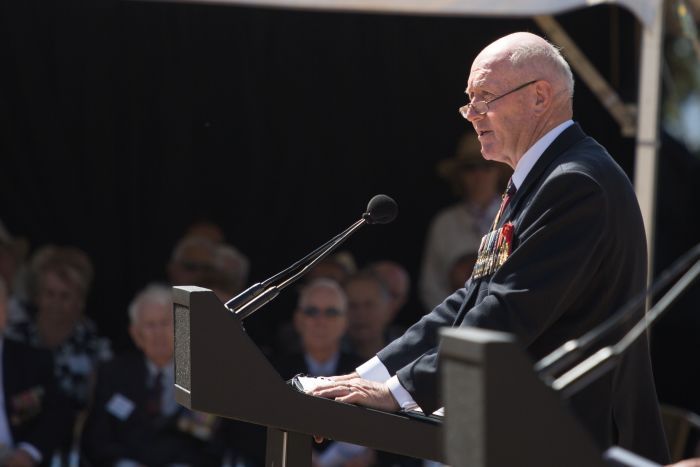 Photo:
Governor General Peter Cosgrove praised those who were starved and beaten to the edge of death. (ABC News: Margaret Burin)
Photo:
Governor General Peter Cosgrove praised those who were starved and beaten to the edge of death. (ABC News: Margaret Burin)
Sixteen veterans of the fall of Singapore and POWs were on hand for the ceremony as the Governor-General thanked them for their sacrifice.
"On your behalf I acknowledge the veterans today. What you've endured, the story of your service and sacrifice touches us all," he said.
"You hold a special place in the heart of all here and in the heart of this nation."
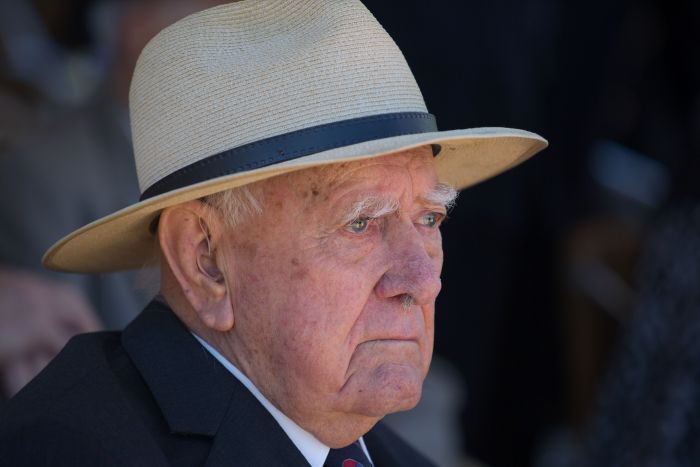 Photo:
Robert Goodwin was one of 16 POWs or veterans who attended the service. (ABC News: Margaret Burin)
Photo:
Robert Goodwin was one of 16 POWs or veterans who attended the service. (ABC News: Margaret Burin)
Dark times for POWs
Britain's wartime prime minister, Winston Churchill, called the fall of Singapore "the worst disaster and the greatest capitulation in British history".
Of the 22,000 Australians taken prisoner by the Japanese, 8,000 never came home.
John Gilmour, 97, spent 18 months at Changi doing slave labour after he was captured with the 2/4th Machine Gun Battalion.
He almost completely lost his eyesight from malnourishment.
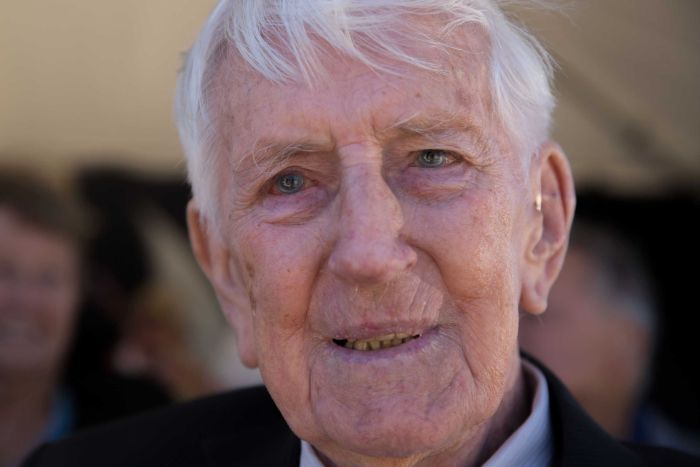 Photo:
John Gilmour did not expect to ever be freed from a prisoner of war camp. (ABC News: Margaret Burin)
Photo:
John Gilmour did not expect to ever be freed from a prisoner of war camp. (ABC News: Margaret Burin)
The West Australian man said his strong will was the only thing that kept him alive.
"We didn't think we'd ever be released because they had us drilled that way … and I suppose they were going to get rid of us all. We were going to be shot," he said.
"It was hard to believe we'd be released, such a shock, because being Japan there was no chance of escape.
"Some of the guys when they'd get sick, they tossed it in. There was no hope of being released. To have the will power to see the day the war was finished. It was a terrific feeling when we knew it was over."
He said it was a special feeling to be at the 75th anniversary ceremony on the other side of the country.
"It's fantastic, at the same time it's just terrible to think that all of my mates are gone. There's only two of us left, out 978 in my unit. It's hard to believe."
Memorial to mothers who lost loved ones
David Manning was luckier than some. He was blown off HMAS Perth in the battle of Sunda Strait while fighting Japanese destroyers.
He managed to make it back to shore after 27 hours in the water.
He has perfected a lifetime of not talking about the atrocities, deciding to keep that "rotten" part of his life buried inside.
Former POW Colin Hamley, 93, placed a poppy next to the name of his brother Don, who he last saw on the Thai-Burma Railway 75 years ago.
Earlier, a statue, titled The Garden of the Grieving Mother, was unveiled by the Governor-General at the Arch of Victory in Ballarat.
The bronze statue will stand as a permanent memorial to the mothers and families who lost loved ones during conflict.
The families of many of those who lost their lives often experienced deep anxiety and grief as they waited on news of loved ones.
The statue was designed by Peter Corlett, who also created the Cobbers statue at Fromelles.
It will stand as the main feature in the garden.
It depicts a grieving mother clutching the photo of her lost son.
Topics: world-war-2, history, community-and-society, veterans, defence-and-national-security, government-and-politics, ballarat-3350, vic, australia
First posted









